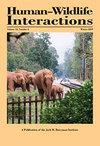土著监护和驼鹿监测:编织土著和西方的认识方式
IF 0.9
4区 环境科学与生态学
Q4 BIODIVERSITY CONSERVATION
引用次数: 9
摘要
全球野生动物物种灭绝、灭绝和减少的速度日益加快,这就要求改进种群监测和管理方法。为了解决区域环境和野生动物问题,全球土著社区正在通过新兴的土著监护计划(IGPs)重新确立作为土地管理者的传统角色。通过为社区一级参与监测和管理提供机会,IGPs有助于促进长期物种保护的凝聚力解决方案,同时促进社区一级的环境管理。解决野生动物监测和管理方面的挑战对于在群落和分布范围内具有文化和生态重要性的物种尤为重要。在此,我们以驼鹿(Alces Alces)为重点描述了加拿大的IGPs,驼鹿是许多土著居民在物种分布中的重要物种。我们概述了适用于加拿大各司法管辖区的常见的西方驼鹿监测方法,并讨论了如何通过土著社区的当地参与来编织土著知识系统和收集信息,从而加强地区一级的监测举措。本文以加拿大不列颠哥伦比亚省Gitanyow地区驼鹿监测与共同管理为例,阐述了驼鹿监护对群落和物种保护的价值。我们的研究揭示了在不断变化的全球环境下,IGPs以及土著和西方知识系统的交织如何有助于维护生态和文化完整性,从而加强野生动物的监测和管理。本文章由计算机程序翻译,如有差异,请以英文原文为准。
Indigenous Guardianship and Moose Monitoring: Weaving Indigenous and Western Ways of Knowing
Increasing global rates of wildlife species extinctions, extirpations, and declines warrant improvements to population monitoring and management approaches. To address regional environmental and wildlife issues, Indigenous communities globally are re-establishing traditional roles as stewards of the land through emerging Indigenous Guardianship Programs (IGPs). By providing the opportunity for community-level participation in monitoring and management, IGPs help foster cohesive solutions for long-term conservation of species while promoting environmental stewardship at the community level. Addressing challenges in monitoring and management of wildlife is especially critical for species that are of cultural and ecological importance at both community and distribution-wide scales. Herein, we describe IGPs in Canada with a focus on moose (Alces alces), an important species to many Indigenous Peoples across the species’ distribution. We outline common Western approaches to moose monitoring applied across Canadian jurisdictions and discuss ways in which weaving Indigenous knowledge systems and information gathered through local participation from Indigenous communities enhances monitoring initiatives at regional levels. We elaborate on a case study on moose monitoring and co-management in the community of Gitanyow in British Columbia, Canada to highlight the value of Guardianship to communities and species conservation in relation to moose. Our study reveals how IGPs and the weaving of Indigenous and Western knowledge systems can contribute to the maintenance of both ecological and cultural integrity to strengthen wildlife monitoring and management under changing global environments.
求助全文
通过发布文献求助,成功后即可免费获取论文全文。
去求助
来源期刊

Human–Wildlife Interactions
Environmental Science-Nature and Landscape Conservation
CiteScore
2.80
自引率
0.00%
发文量
0
审稿时长
11 weeks
期刊介绍:
Human–Wildlife Interactions (HWI) serves the professional needs of the wildlife biologist and manager in the arena of human–wildlife conflicts/interactions, wildlife damage management, and contemporary wildlife management. The intent of HWI is to publish original contributions on all aspects of contemporary wildlife management and human–wildlife interactions with an emphasis on scientific research and management case studies that identify and report innovative conservation strategies, technologies, tools, and partnerships that can enhance human–wildlife interactions by mitigating human–wildlife conflicts through direct and indirect management of wildlife and increased stakeholder engagement. Our intent is to promote a dialogue among wildlife professionals concerning contemporary management issues. As such, we hope to provide a repository for wildlife management science and case studies that document and share manager experiences and lessons learned.
 求助内容:
求助内容: 应助结果提醒方式:
应助结果提醒方式:


